Building the regional understanding of the deep-water geology and benthic ecology of the Great Australian Bight
Andrew Ross A F , Alan Williams B , Asrar Talukder A , Joanna Parr C , Christine Trefry A , Richard Kempton A , Charlotte Stalvies A , Franziska Althaus B , Andrew Kulpecz D , Carole Schaefer E and Phil Rarey DA CSIRO Energy, 26 Dick Perry Avenue, Kensington, WA 6151, Australia.
B CSIRO Oceans and Atmosphere, Castray Esplanade, Hobart, Tas. 7000, Australia.
C CSIRO Minerals, 14 Julius Avenue, North Ryde, NSW 2113, Australia.
D Chevron Australia Pty Ltd, 250 St George’s Terrace, Perth, WA 6000, Australia.
E Chevron Europe, Eurasia and Middle East Exploration & Production Ltd, 1500 Louisiana Street, Houston, TX 77002, USA.
F Corresponding author. Email: Andrew.Ross@csiro.au
The APPEA Journal 57(2) 798-805 https://doi.org/10.1071/AJ16212
Accepted: 9 March 2017 Published: 29 May 2017
Abstract
The Great Australian Bight (GAB) represents one of Australia’s most prospective frontier hydrocarbon exploration regions. Its largest subregion – the Ceduna sub-basin – is a deep (slope to abyss) area of 126 300 km2 with a 15-km deep sedimentary sequence that remains effectively untested. Knowledge of the Ceduna sub-basin’s geology is rapidly evolving following recent collection of 3D seismic datasets, but many questions remain about its geological evolution. The composition of the seabed biota and its ecology in the deep GAB was virtually unknown.
To address a range of geological and biological questions, the multidisciplinary Great Australian Bight Deepwater Marine Program aims to build a more comprehensive regional understanding of the geology of the deep (~700–5437 m) GAB, with a focus on rocky outcrops, segif and volcanic seamounts, and to document aspects of the biota and benthic ecology for the first time.
A field campaign of 63 days in 2015 aboard the RV Investigator and a second support vessel for an Autonomous Underwater Vehicle completed a detailed mapping of 10 225 km2 of seabed. In addition, physical geological and biological sampling collected 1.3 tonnes of volcanic and sedimentary rocks and over 25 553 biological specimens. A surprisingly complex deep-water sedimentary environment was revealed, including several previously unmapped deep-water canyons and 10 previously unmapped volcanic seamounts. A total of 430 species were collected, of which nearly half appeared to be unknown to science.
This paper uses results from this survey to provide insights into the geological processes that have shaped the GAB, and briefly describes the makeup of biological assemblages present on the seabed.
Keywords: Bight Basin, Ceduna sub-basin, fauna, Hammerhead Sequence, outcrop, regional studies, segif, volcanic seamounts.

Andrew Ross is a research scientist based at CSIRO. He leads research projects focussed on marine geology, the development of new hydrocarbon sensor devices and baseline and oil spill monitoring. He and his team have been involved in seep surveys both in Australian basins and in the Gulf of Mexico. More recently he commenced a series of research projects to characterise the geology of the Great Australian Bight. Dr Ross joined CSIRO in 2004 and has qualifications in marine biology, oceanography and petroleum geoscience. |

Alan Williams completed his PhD in Biology at Murdoch University in 1989. He has been a professional marine scientist since then and an employee of CSIRO for the last 26 years where he is now a Principal Research Scientist. |

Asrar Talukder is a Senior Research Scientist at CSIRO. He completed his PhD at the University of Granada in Spain in 2003. From 2004 to 2007, he worked as a postdoctoral research fellow at the GEOMAR – Helmholtz Centre for Ocean Research at Kiel, Germany. During his postdoctoral work, Asrar worked on the gas hydrate deposit mechanisms of the Pacific Margin, offshore Central America. In late 2007, he jointed CSIRO Energy based in Perth. Asrar’s main research interest is submarine natural seep plumbing systems, seabed processes associated with the segif including submarine landslides, and migration of hydrocarbons from the seabed to the sea surface. |

Joanna Parr gained her PhD in 1988 (University of Wales) on the genesis of ore deposits in a Proterozoic volcanic sequence in central Sweden. After a postdoc at Newcastle University (NSW) she joined CSIRO as a research scientist specialising in modern ore-forming environments. She is now a leads the Ore Deposit Geology Group in the Discovery Program of CSIRO Mineral Resources. Joanna is the Honorary Secretary of the Geological Society of Australia and is also a member of the London Geological Society, the Society of Economic Geologists and American Geophysical Union. |

Christine Trefry is a research scientist with the CSIRO Energy Business Unit and is currently a Database Manager/Data Manager/GIS Officer. She works developing MS Access databases for various groups within the business unit, as well as managing the data holdings from different projects. Prior to this she held positions with a local government council in Perth and the Northern Territory Government as an Information Technology Support Officer. |

Richard Kempton is a Senior Research Scientist with the CSIRO Energy Business Unit and is currently leading the Petroleum Systems team. He has more than 15 years of experience in fluid inclusion research with CSIRO and undertakes charge history analysis for industry and government organisations. Prior to this he held a positon with Queensland Gas Co. Richard has a BSc (Hons) (Melbourne) and a PhD (UWA) in geology. He is a member of PESA and the Geological Society of Australia. |

Charlotte Stalvies is a Senior Experimental Scientist with the CSIRO Energy Business Unit. Since joining CSIRO in 2008, Charlotte’s work has focussed on establishing best-practise approaches to hydrocarbon sampling in marine environments, investigating natural hydrocarbon seepage as well as oil spill preparedness, response and monitoring. As a result, Charlotte has led the design and implementation of sampling campaigns in the Gulf of Mexico, Perth Basin, Timor Sea and Great Australian Bight. Charlotte has a Geology Degree from the University of Oxford (UK) and is a member of PESA. |

Franziska Althaus completed her degree in Marine Biology at the University of Tasmania in 1995. She has been a professional marine scientist since then and an employee of CSIRO for the last 20 years where she is now a Research Support Scientist. |

Andrew A. Kulpecz is currently Team Lead, Great Australian Bight Exploration for Chevron Australia Pty Ltd, Perth, a position he assumed in 2016. He completed his BA in geology from Wheaton College (IL) and MSc and PhD in sequence stratigraphy from Rutgers University. Andrew joined Chevron in 2008 as a geologist and has worked on a variety of reservoir characterisation and exploration projects spanning Angola, offshore Newfoundland, Australia and emerging opportunities in the Russian/Norwegian Arctic. In 2014 he assumed leadership of Chevron’s Greater Gorgon Exploration team and was responsible for exploration activities in the Carnarvon basin with a focus on delivering future growth for the Gorgon and Wheatstone LNG projects. Throughout his career he has also been heavily involved in instructing Chevron classroom and field-based courses in clastic stratigraphy across the globe. He is a member of GSA, AGU and PESA. |

Carole Schaefer is an exploration and new ventures manager for Chevron, currently based in Houston. As the Great Australian Bight Exploration Manager in Perth, Carole coordinated Chevron’s geologic evaluation of the Bight Basin and was instrumental in the initiation of the Bight Deepwater Marine Program with CSIRO. She is now managing Chevron’s exploration programs in the former Soviet Bloc countries. Carole joined Chevron in 1980 and has degrees in physics and geophysics. |

Phil Rarey joined Chevron in 1985 as an earth scientist working in multiple North America locations including the Alaska North slope, Beaufort Sea, Offshore California, Onshore California and the Gulf of Mexico. He spent 10 years working and living in West Africa in a variety of exploration and development leadership assignments in the deep-water offshore areas of Namibia, Angola, Congo, DRC, Equatorial Guinea and Nigeria. This work included a leadership role in the elimination of routine gas flaring in many offshore areas of Africa. More recently he has held management exploration and development positions in north-west Australia. He is currently an Exploration Manager for Chevron Australia. Phil has a BSc from the University of Colorado and a MSc in Geology and Marine Geophysics from Oregon State University. This work focussed on interpretation, seismic imaging and mapping of marine deposits. He has been a member of AAPG for 35 years and served as president of the Coast Geological Society. |
References
Harris P., Radke, B., Smith, A., Glen, K., Rollet, N., Exon, N., Passlow, V. (2000). Marine geological data collected during Southern Surveyor Voyage 01/00: Eastern Bass Strait and Great Australian Bight. AGSO Research Cruise No. 224. AGSO Record 2000/43.Hill, P. J., and De Deckker, P. (2004). AUSCAN seafloor mapping and geological sampling survey on the Australian southern margin by RV Marion Dufresne in 2003: final project report. Geoscience Australia Record 2004(04).
Hughes, M. G., Nichol, S., Przeslawski, R., Totterdell, J., Heap, A. D., Fellows, M. and Daniell, J. (2009). Ceduna sub-basin: environmental summary. Geoscience Australia Record 2009/09.
Rogers, P., Ward, T., van Ruth, P., Williams, A., Bruce, B. D., Connell, S. D., Currie, D. R., Davies, C. R., Evans, K., Gillanders, B. M., Goldsworthy, S. D., Griffin, D. A., Hardman-Mountford, N. J., Kloser, R. J., Middleton, J. K., Richardson, A. E., Ross, A., Tanner, J. E., and Young, J. (2013). Physical processes, biodiversity and ecology of the Great Australian Bight region: a literature review. Available at http://www.misa.net.au/__data/assets/pdf_file/0006/259620/GAB_Literature_Review_rogers_et_al._2013_ExecSummary_and_Contents.pdf [Verified 14 March 2017].
Tapley, D., Mee, B. C., King, S. J., Davis, R. C., and Leischner, K. R. (2005). Petroleum potential of the Ceduna Sub-basin: impact of Gnarlyknots-1A. The APPEA Journal 45, 365–380.
Totterdell, J., and Mitchell, C. (Eds) (2009). Bight Basin geological sampling and seepage survey: RV Southern Surveyor SS01/2007. Geoscience Australia Record 2009/24.
Willcox, J. B., Stagg, H. M. J., and Davies, H. L. (1988). Rig Seismic Research Cruises 10 & 11: structure, stratigraphy and tectonic development of the Great Australian Bight Region, preliminary report. Bureau of Mineral Resources, Geology and Geophysics Record No. 199/13.


